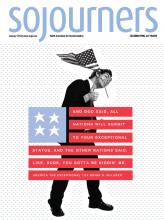BY THE TIME you read this, the Occupy Wall Street campaign may have fizzled or frozen, but even so it stands as the most significant truly grassroots, outside-the-system political eruption since the Great Crash of September 2008.
Some pundits have been calling Occupy Wall Street the tea party of the Left. But that’s not fair to the Occupiers. The tea party never mustered this many people for such a sustained effort, and the tea party has never been a truly independent, grassroots movement, not with former member of Congress and Big Pharma lobbyist Richard Armey pulling strings from the beginning.
The closest the Occupy movement has come to “establishment” support has been some help from organized labor. But the unions aren’t really a significant part of America’s power structure anymore, and the fact that they were willing to help the Occupiers shows they’ve finally begun to realize that. In fact, the leaderless DIY movement in Lower Manhattan has done something the labor movement should have pulled off years ago—a mass confrontation with the plutocrats who are steering the economy toward greater deindustrialization and inequality.
The unions are famously in decline, but they still have more than 14 million dues-paying members, and that dwarfs every other social force in the U.S. The Occupy Wall Street website proclaims the movement’s kinship with the revolutionary tactics of the Arab Spring. But the Occupy movement lacks the organic connection to the mainstream population that animated the streets of Egypt in February 2011. However, if the unions ever mobilized even 10 percent of their membership for an “occupation” of the seats of power, we really would have our own Tahrir Square.
Read the Full Article
